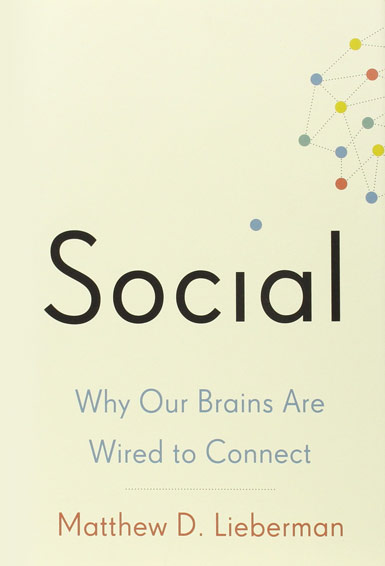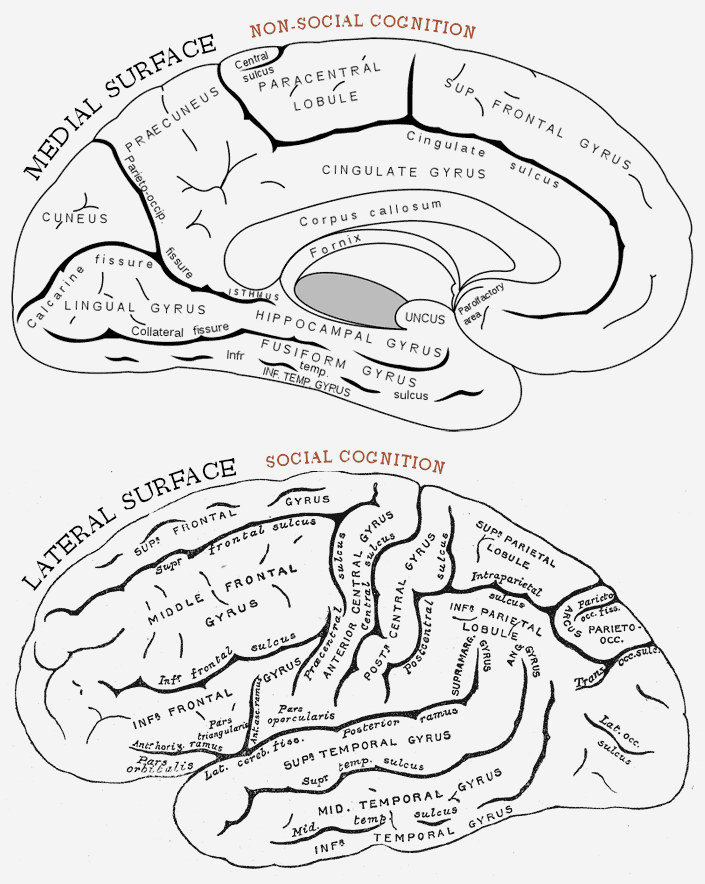Featured Book
Social
Why Our Brains are Wired to Connect
Matthew D. Lieberman
Paperback edition 2014
Featured Book
Our brains are wired for connection, mind reading, and harmonizing—the social and cognitive functions that ensured our survival and continue to drive our behavior. Understanding these neurocognitive mechanisms is essential for reorienting and improving ourselves and our institutions to meet the challenges of our time.
From the First Chapter:
“Connection: Long before there were any primates with a neo-cortex, mammals split off from other vertebrates and evolved the capacity to feel social pains and pleasures, forever linking our well-being to our social connectedness. Infants embody this deep need to stay connected, but it is present through our entire lives.
“Mindreading: Primates have developed an unparalleled ability to understand the actions and thoughts of those around them, enhancing their ability to stay connected and interact strategically. In the toddler years, forms of social thinking develop that outstrip those seen in the adults of any other species. This capacity allows humans to create groups that can implement nearly any idea and to anticipate the needs and wants of those around us, keeping our groups moving smoothly.
“Harmonizing: The sense of self is one of the most recent evolutionary gifts we have received. Although the self may appear to be a mechanism for distinguishing us from others and perhaps accentuating our selfishness, the self actually operates as a powerful force for social cohesiveness. During the preteen and teenage years, adolescents focus on their selves and in the process become highly socialized by those around them. Whereas connection is about our desire to be social, harmonizing refers to the neural adaptations that allow group beliefs and values to influence our own.”
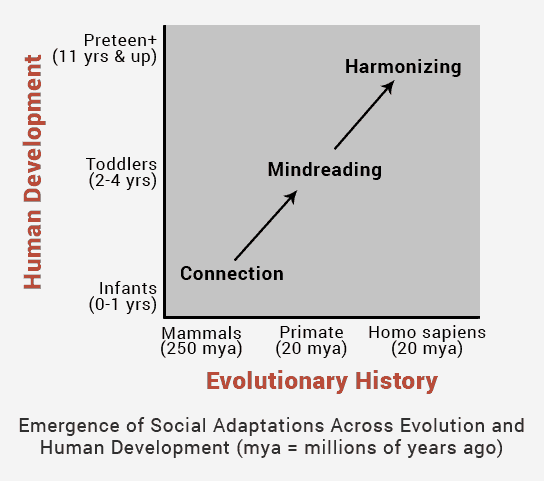
Although social and non-social thinking feel similar, they involve entirely separate mental processing systems in the brain. Non-social cognition, such as general intelligence, problem-solving, and related intellectual abilities, activates mostly the brain’s lateral surfaces. Social cognition: thinking about oneself, others, and one’s relations with others, activates mostly the medial regions.
Typically, when either the social or the non-social cognitive mode is active, the other and its associated brain regions are inactive. The two types of skills compete with each other, so a deficit in one area could lead to additional strength and influence in the other.
This may well explain why children with Asperger’s tend to perform exceptionally well at non-social cognitive tasks but display poor social skills.
Unexpectedly, it turns out that the social cognition regions of our brains are more activated when other neural networks are idle and we are doing nothing! Called “the default network”, this innate tendency is like a reflex, pushing us to think about our social world: about other people’s thoughts, feelings, and goals. “It is the brain’s preferred state of being,” Lieberman writes, “one that it returns to literally the second it has a chance.”
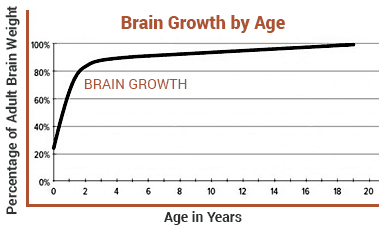
Even two-day old infants activate this default network. It’s not seen in premature infants, so the conjecture is that it is set to turn on when we are most likely to be born. Since the brains of human newborns are only ¼ of their adult size, most brain development happens after birth, when the child is immersed in its culture and environment. Social connection ensures infants’ survival; their safety and physiological needs are dependent on it. Moreover, unmet social and psychological needs create pain that is just as real as physical pain and equally rooted in the physical processes of the brain. It turns out that our brains use the same neural circuitry to experience threats to our social connections as they do when we feel physical pain.
We are Hard-Wired to Reach Out and Interact with Others
This socially malleable sense of self has distinguished us and made us the most successful species on earth. For us, social connectedness is as necessary as food and warmth. Unlike most other animals, human parents stay attached to their children and other family members for their lifetime, and our societies thrive on understanding, empathy, cooperation, and consideration.
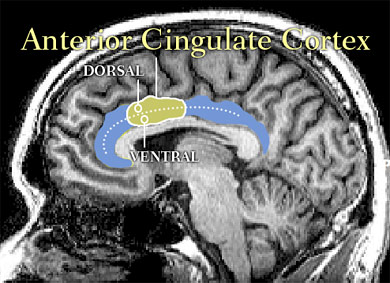
People typically cite among their most painful experiences something involving social, rather than physical, pain: loss of a loved one, having a relationship broken off, or some sort of public humiliation. The word “pain” is used to describe one’s reaction to such events because the brain reacts to threats or damage to social bonds in the same way as to physical pain. Social and physical pain both activate the dorsal anterior cingulate cortex (dACC) which is also linked to mother-infant attachment behavior in mammals. The anterior cingulate cortex (ACC) evolved with mammals and it has the highest opioid receptors of any brain region. A different area, the somatosensory cortex, is responsible for locating and tracking the source of physical pain, but the dACC enables us to experience that pain. The genetic trait associated with high sensitivity to physical pain (the G/G variant of the OPRM1 gene, the mu-opioid receptor gene) is also associated with high sensitivity to social pain. The dACC responds identically, whether the pain is social or physical, which may underlie why we often fail to attribute pain correctly: which kind of pain are we really experiencing, or is it a combination of the two? It also explains why studies show that medications are equally effective at alleviating social pain and physical pain.

Like physical and social pain, physical and social rewards share a common neural network. This network is activated as a response to physical pleasures, such as loving the taste of chocolate, or to the reward of being treated fairly, which is a social connection that implies that we have value in the sight of others and are likely to share in resources at a later time. We have two kinds of social rewards which reflect two different kinds of neurochemical processes: the approval of others and the rewards we receive when we treat others well. The approval of others, even from strangers, promotes opioid-based processes in the brain which gives us the experience of immediate stress relief and pleasure. In the second reward system neuropeptide oxytocin motivates us to help others and diminishes the distress we feel at approaching someone else in distress. It helps us act in others’ interests when we might not otherwise do so.
The approval of others, even from strangers, promotes opioid-based processes in the brain which gives us the experience of immediate stress relief and pleasure.
Evolution adapted our pain and pleasure networks to assure our connection with others, but this need for connection has its downside, too, for example, when we lose a loved one or suffer the end of a long-term relationship. Such losses are leading risk factors for depression and anxiety, and, as we all know, a poor social network is a serious health problem.
Theory of Mind
Understanding that others’ behavior is driven by their own thoughts is called having a “theory of mind,” and when people apply this ability it is called “mentalizing.” Not surprisingly our ability to mentalize largely involves the default system, which turns on during our free moments. Lieberman and colleagues performed a series of tests showing that mentalization is more effective when preceded by a rest period with strong default network activity, and that we use mentalization to evaluate how new information might enhance our social connections. Lieberman points out that understanding another’s point of view and thought process is a kind of mind reading, allowing us to coordinate thoughts with others, cooperate and achieve shared goals. We are not born with this mind reading ability, but begin to develop it as early as age three. It takes effort and practice, but by adulthood this ability is advanced enough to allow us to adjust our behavior to maximize potential for social reward and minimize risk of social pain. Of course, when we can, we use shortcuts to avoid the effort: we often extrapolate from our own mind to project our preferences and thought processes onto others, rather than expending the effort required to determine theirs.
Mirror Neurons
Understanding another’s point of view and thought process is a kind of mind reading, allowing us to coordinate thoughts with others, cooperate and achieve shared goals.
Underlying this mentalization system is something even more basic: the mirror system. In the 1980s scientists were studying how individual neurons in macaque monkeys responded to various actions. They noticed something totally unexpected which changed our basic understanding of how we became such social creatures. Some of the same neurons activated when a monkey performs an action are also activated when it sees someone else – monkey or human – perform that action. So mirror neurons play an important role in a monkey’s ability to imitate the actions of others, and most likely provide a background to its mentalization system as well. It’s interesting to note that if the experimenters merely pretended to perform the action, the neurons were nonresponsive, “perception and action were occurring in the same exact neuron.” Lieberman suggests that mirror neurons may have been the original social media – even, that this was “a way to share what we knew before we were able to say it out loud.”
Lieberman suggests that mirror neurons may have been the original social media…“a way to share what we knew before we were able to say it out loud.”
In 1999, fMRI tests showed a corresponding function in specific regions of the human brain: the premotor cortex in the frontal lobe, the anterior intraparietal sulcus, and the inferior parietal lobule, together known as the “mirror system.” Lieberman reviews current claims regarding the function of this mirror system, while emphasizing that the final story is not yet in. Evaluating a number of current studies and findings from his own team, Lieberman concludes that thanks to the mirror system we live in a world of actions, and we can understand what a person is doing and how he is doing it. But we also live in a world of meaning, where actions have goals and intentions. In order to understand ‘why’ the person is doing that action our mentalization system has to be activated. “The mirror system prepares the brain for mindreading. … [It] chops the world of living movement into pieces, and it repackages them into the psychological elements that the mentalizing system can work from. … Primates have long had a mirror system, but only humans appear to have an advanced mentalizing system. Primates live in a world of what others are doing, but only humans live in a world of why, with the rich means and interpretations to explain the actions of those around us.”
Cooperation and Empathy

No other species cooperates on nearly the scale humans do, and we tend to act cooperatively whether or not it is in our own immediate or later self-interest. Unsurprisingly, it turns out that our reward network is activated when we cooperate: mutual cooperation is an end in itself. However, our ability to connect with each other appears to be so important that a more complex process evolved to prepare and motivate us to do so. Empathy is the result of the coming together of at least three psychological processes: mindreading, affect matching and empathic movitation. The mirror and/or mentalization systems enable us to understand another’s experience; the affect matching process activates the appropriate areas of the brain for whatever sensation or emotion is being experienced by the other and enables us to feel it ourselves; and the septal region which dampens the distress we feel in response to threats, increases our motivation to help and gets all the activated input together to create the empathic motivation which actively gets us to help.
Empathy is quite possibly the height of the social mind and autism the low point on the spectrum. Lieberman outlines many theories as to the cause of this complex disorder. He favors the intense world hypothesis, which suggests that rather than being insensitive to the social world, autistic children are actually hypersensitive to it and so prefer isolation over social contact. As a result they miss out on social learning over a long and crucial period. Children with autism from age 1 or 2 up to 12 years of age have been found to have larger amygdala than typically seen in children of the same age. The amygdala is the integrative center for emotions, emotional behavior, and motivation. It receives inputs from all senses as well as visceral inputs and evaluates their intensity; central to it are negative emotional experiences, like fear and anxiety; it controls our fight or flight response.
Changing Beliefs to Match the Community
In 1918, pink was the preferred color for boys and blue for girls. Over time, everyone’s associations changed until the reverse was true. As the author says: “It is odd how frequently and easily we shift our attitudes along with the masses.”
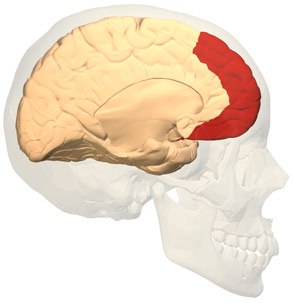
Lieberman and his team studied the involvement of the medial prefrontal cortex (MPFC) in subjects performing direct appraisals of themselves (how they see themselves) and reflected appraisals (how they think others see them). Our conceptual sense of self is strongly tied to the MPFC, which is found only in humans and our closest primate relatives. However, it takes up twice as much space, proportionately, in human brains as in other primates. fMRI studies show that the MPFC is central to self-knowledge and to being influenced by others. It is responsible for one’s sense of “I” but surprisingly, at least from a Western standpoint, the self is primarily a social mechanism which functions to harmonize with others and adapt our personal urges to our need for connectedness.
Lieberman’s studies included adolescents and were the first to look at adolescent’s brains as they try to make sense of themselves. The results suggest that unlike those of adults, the adolescent’s MPFC is involved in both self and reflected appraisals, and if that is so, it implies that the MPFC is involved in the construction of self. Adolescents’ self-appraisals include what they believe others think of them, and involve strong activity in their mentalizing system, implying that although they were asked their own view of themselves, they spontaneously included reflected appraisals: what others thought of them.
“Each of us has a variety of impulses – desires that if acted on at the wrong time, in the wrong place, and with the wrong people, could bring civil society to its knees.”
Further experiments demonstrated that the MPFC is involved in our being influenced to change our beliefs and behaviors. Subjects were exposed to materials designed to persuade them to alter specific behaviors (increase sunscreen use, quit smoking). Those whose MPFC was activated by the materials did change their behavior; those whose MPFC was not activated did not, in spite of their verbal affirmation that they would do so. Furthermore, materials which activated the MPFC of the largest number of people were the most successful in follow up ad campaigns.
“Each of us has a variety of impulses – desires that if acted on at the wrong time, in the wrong place, and with the wrong people, could bring civil society to its knees.” We are evolved to minimize this possibility. While the MPFC ensures that we share society’s beliefs and goals, the ventrolateral prefrontal cortex (VLPFC) matches our behavior to those beliefs and goals. Exercising self-control of any type – motor, cognitive, or perspective-taking (deciding what decision another would make, regardless of one’s own point of view) – activates the VLPFC. It also contributes to regulating emotions and to self-restraint, which is engaged by any sort of simple reminder that we can be seen, judged, and evaluated. Despite our sense of a unique self, we do not always act primarily out of self-interest; instead, our social brain restrains self-interest in favor of harmonizing with society.
Since we are all wired to be motivated by acceptance and being valued by the group, enhancing people’s status, connections, and fairness has positive outcomes in organizations. Our brains have evolved primarily to produce social beings who connect with each other and work together to enable the group to thrive and evolve. The author points out that understanding our social brain can help us reorient our institutions and goals. He includes ideas that might help them become smarter, happier, and more productive.
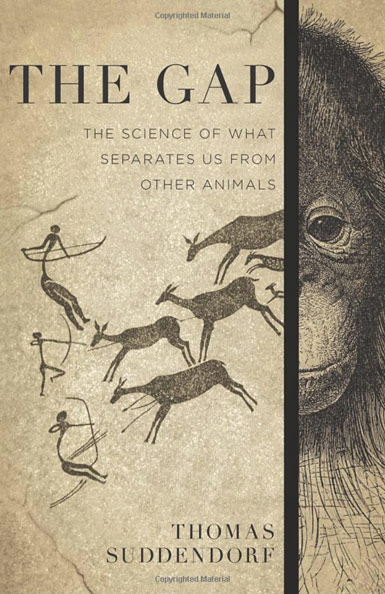
The Gap
The Science of What Separates Us from Other Animals
Thomas Suddendorf
A leading research psychologist concludes that our abilities surpass those of animals because our minds evolved two overarching qualities.

Multimind: A New Way of Looking at Human Behavior
Robert E. Ornstein
This provocative book challenges the most-popularly held conceptions of who we are. In it, psychologist and renowned brain expert Robert Ornstein (1942 – 2018) shows that, contrary to popular and deep-rooted belief, the human mind is not one unified entity but, rather, is multiple in nature and is designed to carry out various programs at the same time.

The Matter with Things
Iain McGilchrist
In his masterly two-volume exploration of our brain hemispheres, Iain McGilchrist argues that in order to understand ourselves, the world and the universe, we need a combination of the right and left hemispheres working in tandem, but with the right brain leading the way.

Beyond Culture:
Edward T. Hall and Our Hidden Culture
Report by John Zada
Edward T. Hall, after spending his early adulthood working and travelling among non-Anglophones, both in the United States and in other parts of the world, became cognizant and fascinated in the deeper layers of culture that he claimed lie buried beneath those more obvious forms.
In the series: Our Mind in the Modern World
- An Ancient Brain in a Modern World
- Our Unconscious Minds
- Maintaining a Stable World
- The Multiple Nature of Our Mind
- Connecting with Others
- Morality’s Long Evolution
- Unconscious Associations
- The Brain’s Latent Capacities
- God 4.0
- Multimind: A New Way of Looking at Human Behavior
- Thinking Big
- The WEIRDest People in the World
- The Righteous Mind
- New World New Mind
- Moral Tribes
- The Mountain People
- The Matter with Things
- Humanity on a Tightrope
- Fluke by Brian Klaas
- Beyond Culture
- Think Again
Further Reading »
External Stories and Videos

Why Facts Don’t Change Our Minds
Elizabeth Kolbert, The New Yorker
Elizabeth Kolbert reviews three books that explain how this alarming tendency evolved and how it might be corrected.
Sociability is the key to how the human mind functions or, perhaps more pertinently, malfunctions. Reason developed not to enable us to solve abstract, logical problems or even to help us draw conclusions from unfamiliar data; rather, it developed to resolve the problems posed by living in collaborative groups, where agreement and stability were crucial. Invariably in-depth understanding leads to more flexible thinking.
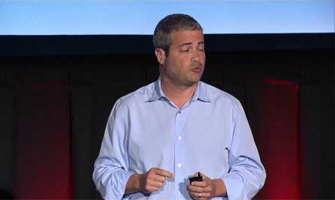

The Social Brain and Its Superpowers
Matthew Lieberman, Ph.D., TEDx
Neuroscientist Matthew Lieberman explains that through his studies he’s learned that our kryptonite is ignoring the importance of our social superpowers and by building on our social intuition, we can make ourselves smarter, happier, and more productive.

